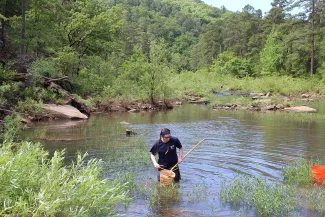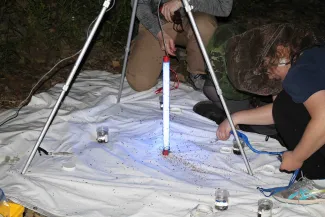“I think most everyone can agree that clean, healthy water is important.”
Rickey Cothran, assistant professor at Southwestern Oklahoma State University, recently spent time surveying streams in southern Oklahoma and heard that sentiment firsthand when chatting with local residents. But his career of studying freshwater systems has taught him that clean and healthy water isn’t only valuable to Oklahomans – it’s also valuable to our fish and wildlife.
Cothran and professor Peter Grant, with a team of undergraduate researchers from SWOSU, and Elizabeth Bergey and graduate student Kambridge (Brown) Stephens, with a team from the University of Oklahoma, recently partnered with the Wildlife Department to learn more about two groups of aquatic insects that are very sensitive to changes in water quality.
“Mayflies and caddisflies are both freshwater, aquatic insects. The immature forms are waterbound, but adults spend their time on land.” While many Oklahomans may not readily recognize the aquatic lifeforms, they may be familiar with the swarms of the mature insects that can be seen flying over the landscape or clinging to windows in years with favorable hatch conditions.
These abundant insects are an important part of the food chain – feeding aquatic larval dragonflies and a number of fish while in the water; and terrestrial animals like bats and salamanders while on land. But mayflies and caddisflies are also feeding the scientific community information. These insects are considered indicator species and help biologists better understand a stream or river’s water quality. “They will be some of the first to drop out of the system if there is contamination, reduced water flows, or an increase in sedimentation. But there will be more species of mayflies and caddisflies in streams with high water quality – those streams that have low contamination, steady flows, and low sedimentation.”
To update the current picture of where these important insects can be found, the research team spent two years splashing through streams and rivers in southeastern Oklahoma’s Ouachita Mountains and south-central Oklahoma’s Arbuckle Mountains. “Our surveys targeted six species of caddisflies and three species of mayflies. We focused on these nine species because there is little to no information about these specific species, or it has been decades since they have been documented in our state.”

The partnering universities split the large study area by ecoregion: Team SWOSU focused on the Little and Kiamichi rivers in southeastern Oklahoma, while Team OU concentrated their survey efforts in a three-county area of the Arbuckle Mountains.
Searching for Mayflies By Day and By Night
“Field work was a pretty grueling experience for the students. We would get out as early as we could and sample four to five sites a day for the aquatic lifeforms,” Cothran said. The teams spent two hours at each site collecting stream samples and taking habitat measurements like water clarity, substrate information and temperature.
“By the time we finished collecting our aquatic samples, it would be approaching dusk. That’s when we would start sampling for the terrestrial adult mayflies and caddisflies.” A series of small unmanned light traps that attracted insects into mesh-covered containers were set, and a larger light trap was set at the night’s final site.
“We would have dinner, spread a white cloth on the ground, turn on a black light, and wait for insects to land on the cloth. After an hour and a half of collecting mayflies and caddisflies at the big light trap, we would retrace our steps and pick up the smaller light traps.”

“It was a lot of fun, but the students were almost always asleep on our late night drives back to basecamp.”
Science: It Takes a Village
During scheduled breaks from the field, the researchers sorted through the aquatic samples at Oklahoma State University’s Kiamichi Forestry Research Station near Idabel or the University of Oklahoma’s Biological Station near Kingston. But finding the small mayflies and caddisflies hidden in the collected vegetation was a time consuming challenge. “A well-trained student could sort through the algae and other things collected in the water samples to find mayflies and caddisflies in one to three hours.”
Those sorted samples would then be shared with the larger group.
“We were able to collect a tremendous amount of material during the project and had a great team working to identify the specimens – Peter Grant with SWOSU identified the collected mayflies, and Dave Ruiter of Oregon identified the caddisflies.”
The project’s results will be shared with the Oklahoma Natural Heritage Inventory to be included in the state’s database. Biologists will be able to then use this information to update the status of these species in Oklahoma. The collections will also be shared with a natural history museum at Colorado State University. Having samples stored at this museum will allow people from all over the world to access the information collected during the project.
“You’re not doing science unless you share the results.”
While Cothran was pleased with the project’s outcomes, he was also thankful his students were able to gain valuable experience in the field.
“My students really enjoyed being in southeastern Oklahoma; seeing the trees, beautiful streams and mountains. It’s a different kind of beauty than the prairie landscape they get to see around Weatherford.”
“But what was most impressive to the students was the sheer biomass found in the samples – that’s why I think every biology student should visit a light trap in southeastern Oklahoma. Those streams are so productive and have a tremendous amount of aquatic insect diversity. It’s really cool to see that linkage between the aquatic and terrestrial.
“A lot of energy flying around and becoming part of the food chain started out in the water.”
This project was funded in part by ODWC’s State Wildlife Grants Program Grant F16AF01215, U.S. Fish and Wildlife Service, Southwestern Oklahoma State University and the University of Oklahoma.